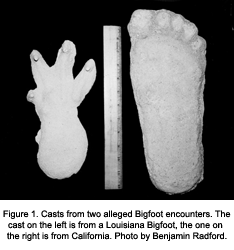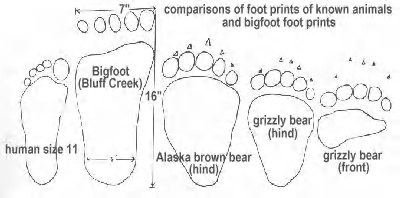|
Why do some tracks show three or four toes?
Are there different species of Sasquatch?
By Michael Killen
 The question about the different number of toes found in many tracks and whether
there is more than one species of Sasquatch is a much debated topic. Some
experts believe that there may indeed be similar but yet somewhat different
species of Sasquatch in North America. The question about the different number of toes found in many tracks and whether
there is more than one species of Sasquatch is a much debated topic. Some
experts believe that there may indeed be similar but yet somewhat different
species of Sasquatch in North America.
Those who subscribe to this theory point out the fact that there are other
differences between what is known as “The Pacific North West Sasquatch” and the
Eastern or Southern versions. In the Eastern and Southern areas of the country
the creatures seem to be more aggressive in nature and much more prone to acting
out territorial displays when compared to the usually less aggressive PNW
Sasquatch. In these areas of the country the creatures are often called
different names like Momo, Booger, Lizard Man, Old Red Eyes, Skunk Ape, and many
others. In these areas the creatures seem to “stalk” people more often,
sometimes following them right out to a roadway or parking area. They may even
“chase” or “herd” people by running behind them at a distance to force people
out of an area very quickly. Many of the tracks found in the Eastern or Southern
states show three or four toes instead of the usual five toes of most tracks in
the PNW. Some have even shown six.
 In comparison, the PNW Sasquatch seem to be much more shy and elusive, usually
just taking a brief look at a person before quickly leaving the area. These
Sasquatch are much less prone to acting out territorial displays and almost all
of the tracks found show five toes. These are the reasons why many believe there
are two different but closely related species of Sasquatch. In comparison, the PNW Sasquatch seem to be much more shy and elusive, usually
just taking a brief look at a person before quickly leaving the area. These
Sasquatch are much less prone to acting out territorial displays and almost all
of the tracks found show five toes. These are the reasons why many believe there
are two different but closely related species of Sasquatch.
However, a very strong argument can also be made for the theory that there is
only one species of Sasquatch in North America. Those who believe in the one
species theory offer the possibility of inbreeding as the most likely reason for
the apparent differences between the creatures. This is a very good possibility
and would easily explain the different numbers of toes found in the tracks and
also the aggressive nature of some Sasquatch. Inbreeding is known to cause
disfigurement in the extremities, including missing fingers and toes, and is
also widely blamed for the aggressive nature of the inbred. This also makes
perfect sense from a geographical standpoint as well. Even though the Eastern
and Southern areas have more overall square miles of forest than the PNW, the
tracts of land are in much smaller separate pieces. Because the tracts of forest
in the East and South are separated by many more roadways and bigger cities than
in the PNW, these creatures are probably forced to stay and mate mostly within
their own territories which causes a much less diverse gene pool than that of
the Sasquatch in the PNW. Because of this the genetic deformities are
handed down from generation to generation thus virtually guaranteeing the
continuation of the aggressive three or four toed Sasquatch. If it turns
out that there is only one species of these creatures, then the inbreeding
theory probably offers the best explanation for the apparent differences
between the Eastern/Southern and PNW Sasquatch.

The photos appear here
under the fair use
for educational purposes of copyright material. |